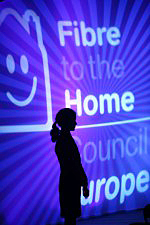 |
Date Announced: 03 Dec 2020
Brussels, Belgium, 03 December 2020 -- Today at the FTTH virtual Conference 2020, the latest figures of the FTTH Forecasts for 2020 and 2026 prepared by IDATE with the FTTH Council Europe’s Market Intelligence Committee were released alongside a flash update of the 2020 FTTH Market Panorama. These numbers were reviewed after the COVID-19 initial wave during 2020.
These market forecasts cover 39 countries1 and provide an individual analysis for 15 countries2.
Estimates plan for a massive surge to around 202 million homes passed for FTTH/B in 2026 in EU27+UK compared to 26,2 million in 2012. Some countries are expected to experience an outstanding growth in the number of homes passed in 2026 compared to 2019 such as Germany (+730%), United Kingdom (+548%) and Italy (+218%).
Looking at the ranking of countries, while Russia is likely to continue leading the charge in terms of FTTH/B homes passed, it is anticipated that Germany would join the second spot in the ranking in 2026.
According to the forecasts, the number of subscribers would increase further to around 148 million in 2026 for EU27+UK and approximately 208 million for EU38+UK and the FTTH/B take-up rate3 would reach 73,3% in 2026 showing a clear upward trend compared to a recorded 23,4% in 2012.
Covid-19 can partially explain this massive growth as it led to more data traffic and new broadband demands with people staying at home, which in turn increased the demand for fibre. But it is to be considered as an accelerator which amplified pre-existing trends.
However other factors also affect positively FTTH adoption such as:
Finally, while FTTH/B deployments are intensifying across Europe it is worth noting that a new digital divide for teleworking performance was revealed by the Covid-19 crisis. Beyond its impact on public policies, it is now clear that Covid-19 has changed public perception of the importance of broadband and their willingness to accept premium for fibre. This new trend is one of the key drivers for the very high estimates for FTTH/B take up however additional measures by policy-makers aimed at increasing take-up are still crucial for European citizens and businesses to benefit from the potential of full fibre.
The presentation about the Market Panorama 2020 (figures from September 2019 and excluding the update presented at the FTTH virtual Conference on 3 December) is available here and the corresponding press release here.
E-mail: info@ftthcouncil.eu
Web Site: www.ftthcouncil.eu
| © 2025 SPIE Europe |
|